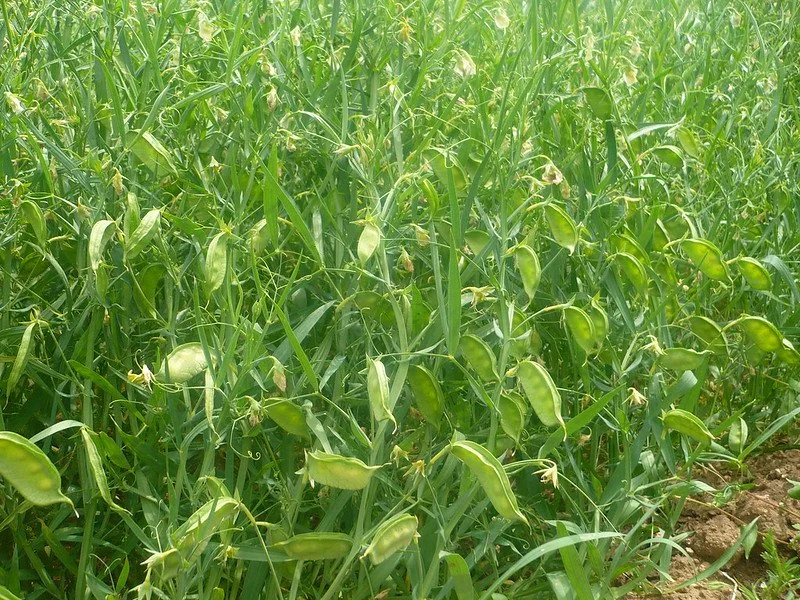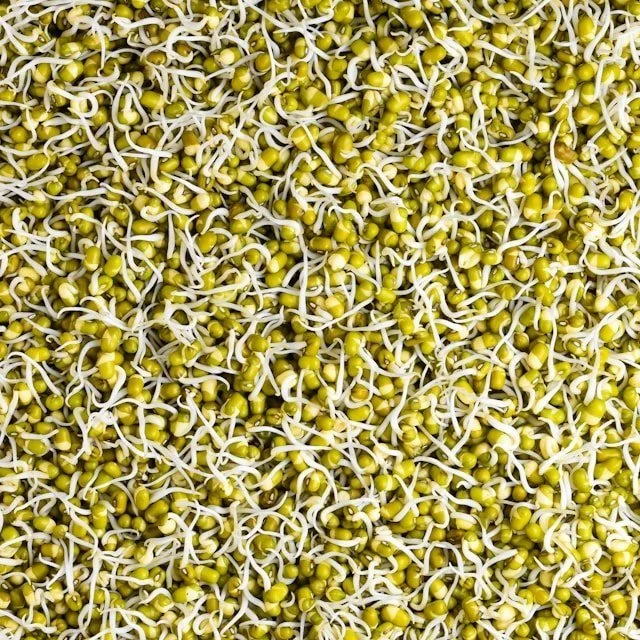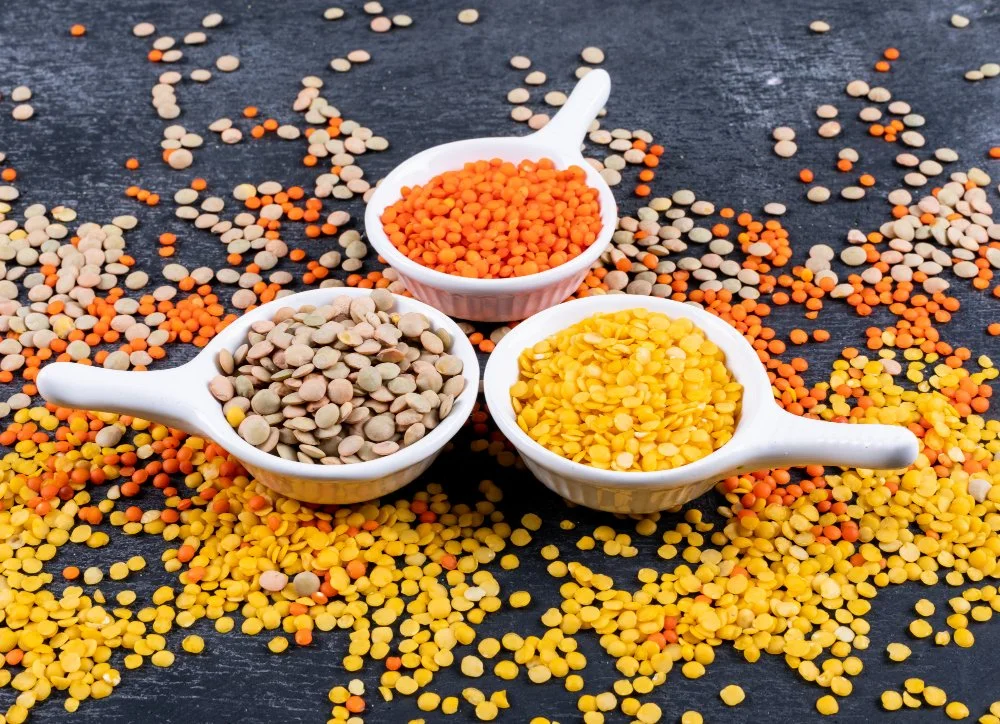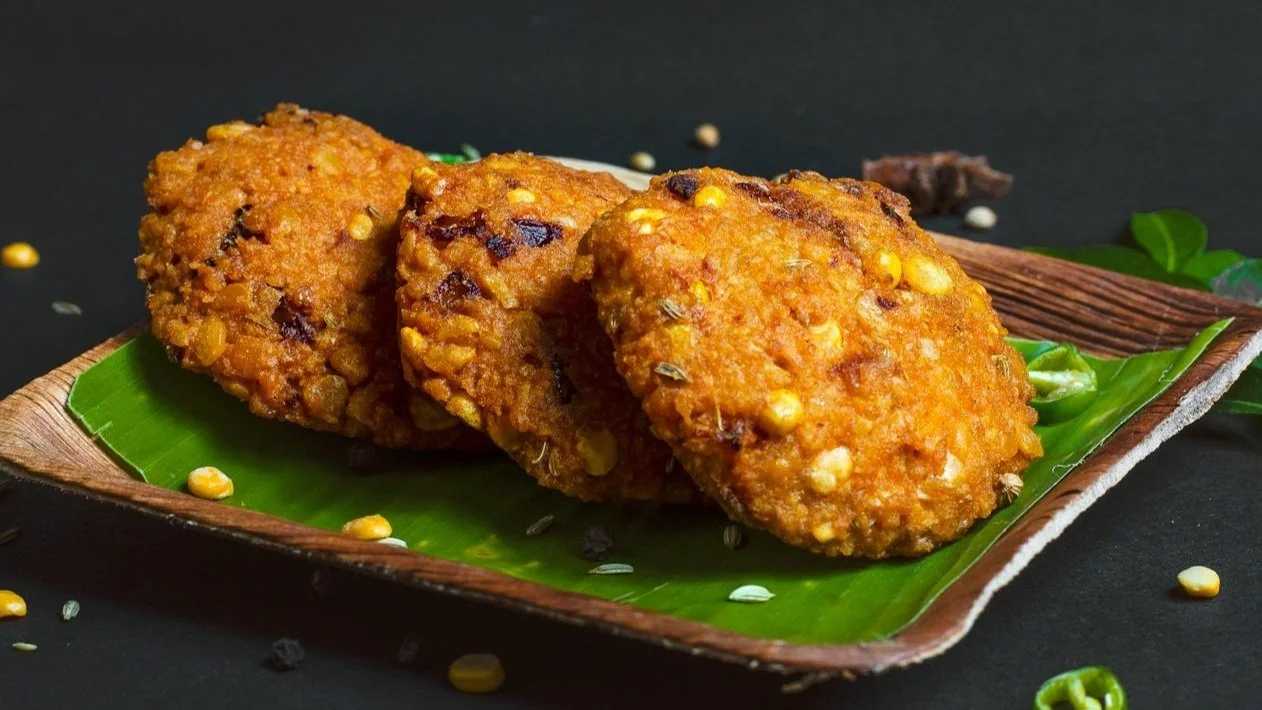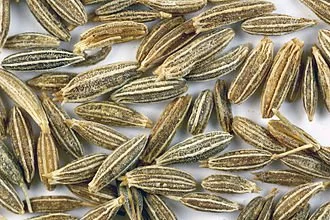Lentils: Going Beyond the Soup Bowl
These days, I’m leaning towards a more plant-based diet. I’ve done so many diet iterations I’ve lost count and, while they’ve each served their purpose at the time, what I’ve realized is that - I love eating plant foods! (Actually, I love eating period. 😉)
Lately, I’ve been experimenting more with whole grains and pulses. Whole grains are grains that have not been refined, meaning they retain all parts of the kernel: the bran, germ, and endosperm, making them more nutritious. Examples include brown rice, whole wheat flour, oatmeal, and quinoa. Pulses are the dry, edible seeds of legumes (plants that are known for producing seeds in pods). This includes beans, lentils, peas, and chickpeas. These are foods that are typically focused on when eating a plant-based diet whether that’s vegan, vegetarian, or a lower meat omnivore.
In this blog, I’m exploring lentils. They’re making a strong resurgence in modern kitchens and not just because they’re cheap and easy to prepare. Lentils are back in style because they check every box: nutritious, sustainable, affordable, versatile, and rooted in global culinary traditions. As more people seek out foods that nourish both body and planet, lentils have reemerged as a smart, satisfying choice—no longer seen as “hippie food,” but as a staple of the future.
Photo by https://flic.kr/p/c5TJ2Y
A Brief Journey Through Lentil’s History
Lentils are one of the oldest cultivated crops in human history, with evidence of their domestication dating back over 9,000 years. They originated in the Near East, in what is known as the Fertile Crescent - a crescent shaped region in the Middle East that encompasses spanning modern-day Iraq, Israel, Jordan, Lebanon, Palestine, Syria, northern Kuwait, south-eastern Turkey, and western Iran.
Archaeological findings indicate that lentils were among the first crops cultivated by humans as they transitioned from nomadic hunting and gathering to settled agriculture. Other early crops are barley and wheat.
Lentils are mentioned throughout ancient texts and traditions. In the Bible, Esau trades his birthright to his brother Jacob for a bowl of lentil stew. In the Hindu text, Mahabharata, the hero Bhima - a strong and resilient warrior - is said to cook and eat lentils. The ancient Egyptians ate lentils regularly, and archeologists have discovered lentils in the royals’ tombs as offerings for the afterlife.
Today, lentils remain a cornerstone in many traditional diets and have become a favorite for modern health-conscientious home cooks looking for sustainability, economy, versatility, and flavor.
A Highly Sustainable Food Choice
Lentils offer numerous environmental benefits. They require significantly less water and land to grow compared to many other protein sources, such as beef or pork. They also require less fertilizer, pesticides, and water than other crops giving them a smaller carbon footprint.
Lentils are also nitrogen-fixing legumes, which means they naturally enrich the soil by converting atmospheric nitrogen into a form that plants can use, reducing the need for synthetic fertilizers. Lentils are among the lowest-carbon protein sources. The fact that they emit such a small amount during growing combined with their sequestering of carbon in the soil actually results in a net negative carbon footprint which helps mitigate climate change.
Additionally, their short growing cycle allows for multiple harvests in a year, contributing to efficient land use. As part of a crop rotation system, lentils help improve soil health, reduce disease and pest pressure, and maintain biodiversity.
Lentil Varieties
There are many different types of lentils, each with their own unique characteristics. Each one brings something different to the table and experimenting with the different varieties can transform how you use lentils when you cook.
Green Lentils are pale green to speckled or mottled green (like French green lentils). They have an earthier, slightly peppery flavor and remain firm when cooked. They are excellent for salads, grain bowls, or any dish where you want to retain the firm texture.
French Green Lentils ‘Lentilles du Puy’ are a darker slate green color with blue-black speckles. These lentils are very firm and hold their shape exceptionally well while contributing a deep, mineral-like, slightly peppery flavor to the dish. They are typically used in fancy salads, side dishes, or alongside roasted veggies.
Red and Yellow Lentils As the names suggest, these lentils are a bright orange to pale yellow color. They have a more delicate sweeter taste and become soft and mushy when cooked making them perfect for soups, Indian dal, and purees.
Black Beluga Lentils Also known as ‘caviar lentils’, these lentils are small and shiny black resembling caviar in appearance. They have a rich, earthy flavor and keep their shape, al dente texture, and gloss when cooked. Teir umami-rich flavor pairs well with wine reductions making them suitable for appetizers and elegant entrees.
Sprouting Lentils
Sprouted lentils offer enhanced nutritional benefits compared to unsprouted ones. Sprouting increases levels of vitamins (especially A, B, C, and E), minerals like iron and zinc, and antioxidants. The process improves protein quality and digestibility, making nutrients more accessible.
Sprouting also reduces antinutrients such as phytic acid and lectins, which boosts mineral absorption. Additionally, sprouted lentils are higher in fiber, lower in calories, and have a low glycemic index, supporting blood sugar control and weight management. Overall, sprouted lentils are more nutrient-dense, easier to digest, and offer greater health benefits than regular lentils.
How to Sprout Lentils Step-by-step:
Rinse and Soak: Rinse lentils well and remove any debris. Place in a jar and cover with water (about 3x the volume of lentils). Soak for 8–12 hours or overnight.
Drain and Rinse: Drain the water and rinse the lentils. Return them to the jar, cover with mesh or cheesecloth, and place the jar at an angle to drain excess water and allow air flow.
Sprout: Rinse and drain the lentils twice a day. Keep them in a cool, dark place. In 1–2 days, small sprouts (“tails”) will appear. After 2–4 days, when the tails are about the same length as the lentil, they’re ready to eat.
Store: Once sprouted, let them dry and store in the fridge for up to a week.
Tip: Use organic, whole lentils for best results—split or hulled lentils will not sprout well
Soaking Lentils
Soaking lentils before cooking significantly reduces antinutrients like phytic acid and tannins, which improves the absorption of minerals such as iron and zinc. It also decreases flatulence-causing sugars, making lentils easier to digest and less likely to cause gas.
Soaking enhances overall digestibility and shortens cooking time, helping to preserve some nutrients. While there may be minor losses of water-soluble vitamins (like thiamin and niacin), protein content remains largely unchanged.
Overall, soaking lentils boosts their nutritional quality and makes them gentler on the digestive system without substantially reducing their health benefits.
Basic Cooking Instructions
Rinse: Always rinse lentils before cooking to remove dust or small stones.
Simmer: Use a ratio of 3 cups water to 1 cup lentils. Bring to a boil, then reduce heat and simmer.
Cook Time:
Red/yellow lentils: 15–20 minutes (turn soft).
Brown/green lentils: 25–30 minutes.
French green/black lentils: 30–35 minutes.
Cooking Tips
Don’t add salt or acidic ingredients (like vinegar or tomatoes) until lentils are tender; these can slow down cooking.
Add aromatics like bay leaves, garlic, onion, or thyme to the water for extra flavor.
Cook a large batch and store in the fridge for up to 5 days or freeze for up to 3 months.
Popular Lentil Recipes
Dal – A rich, spiced Indian stew often made with red lentils.
Mujadara – A Middle Eastern dish of lentils, rice, and caramelized onions.
Lentil soup – Hearty and comforting, made with vegetables and brown or green lentils.
Lentil salad – Cold or warm, often with French green lentils, vinaigrette, and seasonal vegetables.
Lentil loaf or burgers – A vegetarian alternative using brown or green lentils.
Lentil curry – Coconut milk, spices, and red lentils come together in a quick, creamy dish.
What Do Lentils Taste Like?
The flavor of lentils is often described as earthy, nutty, or even slightly peppery depending on the variety. They are deeply savory and satisfying on their own but also work beautifully as a blank canvas for spices, herbs, and aromatics.
Brown and green lentils taste mellow and hearty.
French green lentils are more intense and almost mineral-like.
Red and yellow lentils are sweeter and more delicate.
Black lentils have an umami-rich flavor that pairs well with wine reductions or cheese.
Because they absorb flavors well, lentils can adapt to a wide range of global cuisines—from Indian curries to Mediterranean salads, Latin American stews to American comfort food.
How to Buy
You can find lentils in most grocery and health food stores. They are usually by the rice, soup mixes, or ethnic food aisles. They can also be purchased online. If you’re in a growing area like Montana, North Dakota, Washington, or Idaho, you may be able to get them at your local farmers’ market during the harvest season.
Buying Tips:
Dried lentils are the most commonly found and are cost effective. Look for whole, unbroken lentils with consistent color. Be sure to check the best-by date to ensure freshness.
Pre-cooked or canned lentils offer convenience but can be softer in texture and higher in sodium. Be sure to rinse before use.
Split lentils - which are common in Indian cooking - cook faster but have a mushier texture making them better suited for soups and stews.
Specialty varieties like French green or black lentils may be available in natural food or specialty stores or online.
Storing Your Lentils
Dry Lentils Keep the dry lentils in an airtight container in a cool, dry, and dark place, typically a cupboard or pantry. They can last up to a year or more, though older lentils may take longer to cook.
To further protect the lentils from pests such as weevils and moths during storage, consider adding bay leaves, neem leaves, or dried lemon peels to the container.
Vacuum sealing is an excellent method for long-term storage because it removes air thus reducing spoilage.
Cooked Lentils After cooking lentils, they can be stored in an airtight container in the refrigerator for 5-7 days. They can be frozen for even longer, for up to 6 months. Be sure to freeze in small portions for easy use.
Photo by Ananthan Chithiraikani on Unsplash
Key Health Benefits
Lentils are a small but mighty food when it comes to health benefits. Packed with nutrients and incredibly versatile, studies show they support your body in a variety of meaningful ways. Here are some of the top health benefits of eating lentils:
High in Plant-Based Protein Lentils provide about 18 g of protein per cooked cup. Protein is essential for repairing and building tissues, supporting immune function, and helping you feel full and satisfied after eating. When paired with other grains like rice or quinoa, it forms a complete protein - containing all nine essential amino acids.
Multisystem Health Support Lentils contribute to your cardiovascular health in multiple ways. First, their potassium content helps regulate blood pressure because it balances the effects of sodium. Then, folate, a B vitamin found abundantly in lentils (provides 90% RDI per cup), which is important in pregnant women for fetal development and it also helps lower homocysteine levels which is good because increased levels are linked to heart disease.
Folate is also crucial for DNA synthesis and repair, red blood cell formation, and brain function. Adequate intake is linked to reduced risk of cognitive decline and depression.
Finally, lentils are fiber rich which helps reduce both total and LDL cholesterol. The prebiotic fiber in lentils feeds beneficial gut bacteria, helping to maintain a balanced and diverse gut microbiome. A healthy gut flora is linked to improved immune function, better digestion, reduced inflammation, and even enhanced well-being.
Blood Sugar Regulation With a low glycemic index (GI) and high fiber content, lentils are digested slowly, leading to a gradual rise in blood sugar. This is particularly beneficial for those with insulin resistance, pre-diabetes, or type 2 diabetes.
Mineral Rich Lentils are particularly rich in plant iron (3.3 mg/cup - 37% RDI for women) and studies have shown eating cooked lentils prevents iron deficiency anemia. It is also essential for producing hemoglobin, the protein in red blood cells that carries oxygen throughout the body. They also are good sources of several other minerals (zinc, magnesium, copper, manganese, molybdenum, selenium and boron) and vitamins (thiamine, riboflavin, niacin, pantothenic acid, pyridoxine, folate, α, β and γ tocopherols and phylloquinone).
Fragrant, earthy, and unmistakably bold, cumin (Cuminum cyminum) is one of the most recognizable spices in the world and has been used for thousands of years. Native to the eastern Mediterranean and Southwest Asia, cumin seeds have been discovered in Egyptian tombs dating back to the 2nd millennium BCE. The ancient Egyptians used it for preserving mummies, while Greeks and Romans prized it both for cooking and as a symbol of frugality and diligence.
In India, cumin (jeera) has long been an essential spice, appearing in Ayurvedic texts and traditional healing practices. Today, India is the largest producer and consumer of cumin, accounting for about 70% of global production and consuming 90% of what it grows. It was also a part of traditional Arabic and Persian medicine. Cumin’s popularity spread along ancient trade routes, including the famous Silk Road, eventually landing in North Africa, Europe, and the Americas, adapting to the flavor profiles of each region.
What Does Cumin Taste Like?
Cumin has a bold and distinctive flavor profile. It's warm and earthy, nutty and slightly peppery, and pungent with a smoky undertone. It’s slightly bitter on its own, but mellow and rich when toasted or combined with fats.
It goes well with spices like coriander, chili, and turmeric and is commonly used in savory dishes but adds a delightful dimension to sweet dishes as well.
Its strong aroma comes from volatile oils like cuminaldehyde, which are released most when the seeds are toasted or ground fresh.
Cumin balances sweetness in stews or root vegetables, and lifts legumes and grains with its intense aroma. Cumin is a key ingredient in several spice blends where it adds depth and grounding. These blends include chili powder, curry powder, Adobo seasoning, and Shawarma seasoning.
It also features prominently in blends like Ethiopian Berbere, garam masala, Baharat, classic taco seasoning, and is even used in some cheeses (like Dutch Leyden cheese) and traditional breads in France and elsewhere.
Types and Varieties of Cumin
Even though its known as a spice, cumin seeds are really the fruit derived from a small flowering plant. It’s in the same family as dill, parsley, and carrot. It is not to be confused with “black cumin” (Nigella sativa) or “wild cumin” (Bunium persicum), which are different plants.
While the most common cumin is brown or tan in color (Cuminum cyminum), a few other varieties exist. Each variety can be used differently, depending on the desired intensity and aroma.
Brown/Amber Cumin is the most widely used type, with a warm, nutty, slightly bitter flavor.
Black Cumin (Kala Jeera or Nigella) is often confused with other black seeds, black cumin has a sweeter, earthier, and more aromatic profile. It’s especially popular in Indian, Afghan, and Persian cooking.
Green Cumin is rare and less pungent, with a fresh, slightly grassy flavor. It’s typically used in specialty regional dishes.
Buying Cumin
Because cumin is a seed, you have two options when buying it: whole seeds or ground. Whole seeds keep their flavor longer and are wonderful when toasted and ground fresh. Ground cumin is convenient but loses its potency faster. So when buying it ground, purchase in small batches.
Good quality cumin should have a rich brown color and a strong, fragrant scent. If it smells faint or dusty, it’s more than likely past its prime.
Storing Cumin
As with other spices, store cumin in a cool, dry, and dark spot to preserve its volatile oils. Make sure it’s in an airtight container.
Whole cumin seeds can last from 1-2 years while ground cumin is best used within 6-9 months for peak flavor.
Image from Unsplash
Culinarily Speaking
Cumin has an impressive culinary reach and appears in dishes across nearly every continent:
India: Used in countless dishes, including dals, curries, and spice blends like garam masala. Whole seeds are often added to hot oil in the tempering process (tadka).
Middle East: A key ingredient in falafel, hummus, and spice blends like baharat and za’atar.
Mexico & Latin America: Ground cumin is central to chili, bean dishes, adobos, and taco seasonings.
North Africa: Featured in harissa paste and spice mixes like ras el hanout.
Southwest U.S.: Common in Tex-Mex and barbecue rubs.
Europe: Especially in Eastern European and German sausages, breads, and cheeses.
Its versatility makes it a pantry essential, adaptable to soups, dressings, spice rubs, vegetables, and more.
Key Health Benefits
Cumin is more than just a flavorful spice—it’s been used for centuries in traditional medicine for its digestive, metabolic, and anti-inflammatory properties. Modern research supports many of these uses, revealing a wide range of health benefits from including cumin in your diet regularly.
Supports Healthy Digestion Cumin is best known for its digestive properties. It stimulates the production of digestive enzymes, particularly pancreatic enzymes, which help break down food and improve nutrient absorption. Traditionally used to relieve bloating, gas, and indigestion, cumin can also help soothe an upset stomach. It does this by enhancing gut motility and reducing fermentation in the gut. It may ease IBS symptoms. Additionally, its antimicrobial and antifungal properties may help maintain a healthy balance of gut bacteria helping to reduce inflammation and increasing nutrient absorption.
Rich in Antioxidants and Anti-inflammatory Compounds Cumin seeds are packed with plant compounds like flavonoids, terpenes, and phenols that act as antioxidants, helping protect cells from oxidative stress and free radical damage. Oxidative stress is linked to aging, inflammation, and chronic diseases while free radicals are harmful molecules that damage tissues and cells. The active compounds in cumin, including cuminaldehyde and thymoquinone, exhibit anti-inflammatory effects making it potentially helpful in reducing low-grade, chronic inflammation associated with many modern diseases.
Supports Heart Health Cumin may contribute to better cardiovascular health in several ways. Studies suggest it can help lower blood cholesterol, particularly total cholesterol, LDL cholesterol, and triglycerides, while raising HDL cholesterol. These effects are especially pronounced in people with prediabetes or metabolic syndrome.
Good Source of Key Nutrients Cumin seeds are a source of important vitamins and minerals. One teaspoon of ground cumin has about 1.4 mg of iron (~17% DV) which supports oxygen transport and energy production in your body. It also contains significant amounts of magnesium, calcium, and phosphorus which are especially important for bone and muscle health. Cumin is full of B vitamins which aid in energy metabolism and support the nervous system.
Image by Юлия Скавинская-Абдал Аал from Pixabay
Interesting Cumin Facts
Globally, cumin is the second most popular spice after black pepper, highlighting its widespread culinary importance.
Typically hand harvested.
In the Middle Ages, cumin was believed to keep chickens and lovers from wandering, and carrying cumin seeds at weddings was thought to ensure fidelity and happiness.
Cumin is known by many names worldwide: jeera (Hindi), kamoun (Arabic), cumino (Italian), comino (Spanish), kū míng (Chinese), and kreuzkümmel (German).
Roman emperor Antoninus Pius was nicknamed “the cumin splitter” because of his frugal lifestyle, a reference to the spice’s value and the Roman custom of using cumin as a substitute for the more expensive pepper
Let’s get cooking!
Lentils aren’t just for vegetarians or budget-conscious cooks anymore—they’re a canvas for creativity in the kitchen. Their adaptability means they can take on the flavors of any cuisine: Indian, Italian, Middle Eastern, Latin American, or classic American comfort food. You can dress them up or keep them rustic. They’ll rise to the occasion either way.
Baked Red Lentil and Carrot Vada
Crisp on the outside and tender inside without deep frying, these Baked Red Lentil and Carrot Vadas are made with protein-rich red lentils, sweet carrots, and fresh dill. Gently spiced with cumin, cilantro, and dill they’re a wholesome, plant-based twist on a South Indian classic.
Paired with a creamy Raw Mango & Coconut Chutney, they’re perfect as a snack, side, or main dish.
Baked Red Lentil and Carrot Vada
Ingredients
- 1 cup red lentils (masoor dal)
- ¾ tsp salt, or to taste
- ¼ tsp ground cumin
- ½ tsp ground coriander
- 1-inch piece fresh ginger, peeled
- 1 small green chili, or ¼–½ tsp chili flakes (optional)
- 1 cup grated carrot
- 2 tbsp finely chopped onion
- 2 tbsp chopped fresh cilantro
- 2 tbsp chopped fresh dill
- 1 tbsp olive oil (plus more for brushing)
- Optional: 1–2 tbsp chickpea flour or rice flour if batter feels too wet
Instructions
- Rinse the red lentils thoroughly and soak in water for 30–45 minutes. Drain completely before blending.
- Set oven to 400°F (200°C). Line a baking sheet with parchment paper or lightly grease it.
- In a food processor or blender, combine the soaked lentils, ginger, and green chili (if using). Blend into a thick, smooth batter using as little water as possible—just enough to get it moving.
- Transfer batter to a mixing bowl. Stir in salt, ground cumin, ground coriander, grated carrot, onion, cilantro, dill, and olive oil. If the batter feels loose, add 1–2 tablespoons chickpea or rice flour to help bind it.
- Scoop heaping tablespoons of batter onto the baking sheet and flatten slightly into patties. Brush or spray the tops lightly with olive oil for extra crispness.
- Bake for 12 minutes, then carefully flip and bake for another 5-10 minutes, until golden brown and firm on both sides.
- Enjoy with raw Mango & Coconut Chutney.
Notes
- Swap dill for mint, parsley, or more cilantro if preferred.
- Make them smaller for appetizer style bites, or larger for veggie burgers.
- To pan-fry instead: heat a little oil in a skillet and cook each side for 3-4 minutes until golden.
Lentil-Walnut Burgers
Hearty, satisfying, and packed with rich, savory flavor, these Lentil-Walnut Burgers are a delicious plant-based alternative to traditional patties. Cooked lentils and toasted walnuts form the protein-rich base, while aromatic spices, fresh herbs, and a touch of umami create depth and balance.
Pan-seared or oven-baked to a crisp finish, they hold together beautifully and pair perfectly with your favorite buns, toppings, or grain bowls. Whether you're grilling out or meal prepping for the week, these burgers deliver on both flavor and texture—no compromise needed.
Lentil-Walnut Burger
Ingredients
- 1 tbsp ground flaxseed + 2 1/2 tbsp water (flax egg)
- 3/4 cup raw chopped walnuts
- 1/4 cup rolled oats (gluten free if needed)
- 1/3 cup chopped onion
- 2 cloves garlic, minced
- 3/4 cup cooked brown or green lentils (well drained)
- 1 cup finely shredded carrot or zucchini
- 1 tbsp tamari or soy sauce
- 1 tsp smoked paprika
- 1/2 tsp ground cumin
- 1 tsp finely grated lemon zest
- salt and pepper to taste
- olive oil for cooking
Instructions
- Preheat the oven to 400 degrees F. Line a baking sheet with parchment paper and set it aside.
- In a small bowl, combine the ground flaxseed and water to make the flax egg. Let sit 5 - 10 minutes to thicken.
- Toast the walnuts in a dry skillet over medium heat for 3-5 minutes, until fragrant and lightly browned. Let cool slightly. This is an optional step.
- In a food processor, finely grind the walnuts, oats, onion, and garlic. Do not process so much that you get a paste.
- Add the lentils, carrot, flax egg, tamari, smoked paprika, cumin, lemon zest, salt, and pepper. Quickly pulse the mixture until it just comes together as you want it to retain texture.
- Divide the mixture into 4 balls and place on the baking sheet. Gently press them into four equally sized burgers. If the mixture seems too dry add a bit of water, if too wet add a little more oats.
- Brush the top of the patties with olive oil and bake for 10 minutes.
- Flip the burgers, brush with olive oil, and bake for 8-10 additional minutes until golden brown and crisp on the outside.
- Alternatively, heat a skillet over medium heat with a small amount of olive oil. Cook the patties for 4-5 minutes per side.
- Serve with your favorite toppings and accompaniments!
Notes
- You can refrigerate the uncooked patties for up to 3 days or freeze them (cooked or uncooked) for longer storage.
- Use French green lentils for a firmer texture or brown lentils for a more tender, blended result.
- Add a spoonful of BBQ sauce to the mixture or brush on while cooking for a smoky BBQ flavor.
There you have it!
Let lentils remind you: simple things can be deeply satisfying. Let that simplicity guide you—in the kitchen and beyond.

